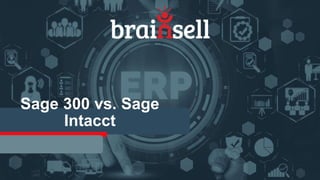Sage 300 vs. Sage Intacct webinar slide deck
- 1. Sage 300 vs. Sage Intacct
- 2. Meet the Team Frank Cuccio Sage 300 and Sage Intacct Implementation Engineer Kellyanne Bonds ERP Account Executive
- 3. Housekeeping ŌĆó 25-minute presentation with 5-minute Q&A at the end ŌĆó Type questions into the "question box" to submit them throughout the presentation ŌĆó We'll send a copy of the deck and recording of the webinar in follow-up emails after the event
- 4. Customer Case Study Challenge: ŌĆó Disconnected systems with disparate and manual workflows impeded productivity ŌĆó Financial reporting insights beyond basics were difficult or not possible to produce ŌĆó On prem server not built for "work from anywhere" model Industry: Higher Education Solutions before Sage Intacct: ŌĆó Sage 300 ŌĆó Microsoft Excel Expensify ŌĆó A manual positive pay process Solutions after migration: ŌĆó Sage Intacct ŌĆó Expensify ŌĆó Bill.com Solution: ŌĆó 25% reduction on time spent cutting checks ŌĆó Slashed days from report preparation ŌĆó Increased automation and flexible accessibility boosted overall finance team efficiency, gaining capacity to scale
- 5. Sage 300 vs. Sage Intacct Sage 300 Sage Intacct On-premises solution that requires hosting and a Remote Desktop connection to provide off-site access capabilities; upgrading versions requires significant time investment Born in the cloud, with a true multi-tenant architecture allowing users access from anywhere; updates are released quarterly, are applied automatically, and require no downtime or consulting services Reporting is labor intensive and often needs re-formatting in Excel; batch- based transaction posting creates a lag between transaction entry and reporting Dashboards and reports deliver instant visibility and eliminate the need for Excel-based reports Limited vertical focus; industry-specific activities are tracked manually Deep vertical focus and automation of key industry processes, eliminating the need for manual tracking Limited marketplace add-ons Best-in-class solution with deep core capabilities; additional functionality can be added through the Sage Intacct Marketplace Uses segmented general ledger accounts, resulting in a huge chart of accounts as well as financial reporting challenges Uses a modern, dimensional account structure which streamlines both the chart of accounts and reporting Multi-entity management needs an add-on for intercompany; consolidation is done through reporting using Sage Intelligence or other external financial reporting tool Multiple entities share the same chart of accounts, customers, and vendors; consolidations and eliminations can be automatic, providing immediate visibility to consolidated results Lacks ease-of-use functionality and makes collaboration difficult Modern, intuitive system, including approval workflows, Collaborate (a Salesforce Chatter tool) , and AI tools, such as GL Outlier Detection, Bank Reconciliation Auto-Match, and Custom Smart Rules & Smart Events
- 6. Sage 300 vs. Sage Intacct Is there an upgrade in your future? It could cost you more to upgrade than to move to a better, more modern, platform Gain control of your business with: Configurable workflow Posting rules Superior audit trail Simplified chart of accounts and reporting General ledger becomes your data warehouse ŌĆō no need for external reporting tools Sage IntacctŌĆÖs entities work together, not separately Dashboards grant visibility into subledger and other processes Never pay to upgrade again! Spend your upgrade dollars to take you to a better place SIŌĆÖs dimensional accounting will make your life easer No more data silos
- 8. Thanks for attending! Schedule your personal evaluation today. (866) 356-2654 sales@brainsell.com www.brainsell.com
Editor's Notes
- #2: 1. How to export reports into excel? 2. How long does it take to migrate? 3. How do I get started migrating from Sage 300 to Intacct? 4. Does Sage Intacct have similar add-ons to Sage 300? 5. We heard that Sage Intacct doesnŌĆÖt do batch processing, why is that and how do you keep tight control for audit purposes?
- #3: Frank
- #4: Frank
- #5: Frank
- #6: Frank
- #7: Frank
- #8: 1. How to export reports into excel? 2. How long does it take to migrate? 3. How do I get started migrating from Sage 300 to Intacct? 4. Does Sage Intacct have similar add-ons to Sage 300? 5. We heard that Sage Intacct doesnŌĆÖt do batch processing, why is that and how do you keep tight control for audit purposes?








